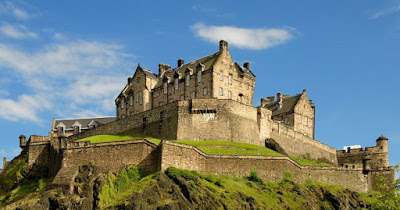Edinburgh
Castle has played a pivotal role in Scottish history, both as a royal residence
– King Malcolm Canmore (r 1058–93) and Queen Margaret first made their home
here in the 11th century – and as a military stronghold. The castle last saw
military action in 1745; from then until the 1920s it served as the British
army's main base in Scotland. Today it is one of Scotland's most atmospheric
and most popular tourist attractions.
The
brooding, black crags of Castle Rock, rising above the western end of Princes
St, are the very reason for Edinburgh's existence. This rocky hill was the most
easily defended hilltop on the invasion route between England and central
Scotland, a route followed by countless armies from the Roman legions of the
1st and 2nd centuries AD to the Jacobite troops of Bonnie Prince Charlie in
1745.
The
Entrance Gateway , flanked by statues of Robert the Bruce and William Wallace,
opens to a cobbled lane that leads up beneath the 16th-century Portcullis Gate
to the cannons ranged along the Argyle and Mills Mount batteries. The
battlements here have great views over New Town to the Firth of Forth.
At
the far end of Mills Mount Battery is the famous One O'Clock Gun , where crowds
gather to watch a gleaming WWII 25-pounder fire an ear-splitting time signal at
exactly 1pm (every day except Sunday, Christmas Day and Good Friday).
South
of Mills Mount, the road curls up leftwards through Foog's Gate to the highest
part of Castle Rock, crowned by the tiny, Romanesque St Margaret's Chapel , the
oldest surviving building in Edinburgh. It was probably built by David I or
Alexander I in memory of their mother, Queen Margaret, sometime around 1130
(she was canonised in 1250). Beside the chapel stands Mons Meg , a giant
15th-century siege gun built at Mons (in what is now Belgium) in 1449.
The
main group of buildings on the summit of Castle Rock is ranged around Crown Sq,
dominated by the shrine of the Scottish National War Memorial . Opposite is the
Great Hall, built for James IV (r 1488–1513) as a ceremonial hall and used as a
meeting place for the Scottish parliament until 1639. Its most remarkable
feature is the original, 16th-century hammer-beam roof.
The
Castle Vaults beneath the Great Hall (entered from Crown Sq via the Prisons of
War exhibit) were used variously as storerooms, bakeries and a prison. The
vaults have been renovated to resemble 18th- and early 19th-century prisons,
where graffiti carved by French and American prisoners can be seen on the
ancient wooden doors.
On
the eastern side of the square is the Royal Palace , built during the 15th and
16th centuries, where a series of historical tableaux leads to the highlight of
the castle – a strongroom housing the Honours of Scotland (the Scottish crown
jewels), the oldest surviving crown jewels in Europe. Locked away in a chest
following the Act of Union in 1707, the crown (made in 1540 from the gold of
Robert the Bruce's 14th-century coronet), sword and sceptre lay forgotten until
they were unearthed at the instigation of the novelist Sir Walter Scott in
1818. Also on display here is the Stone of Destiny .
Among
the neighbouring Royal Apartments is the bedchamber where Mary, Queen of Scots
gave birth to her son James VI, who was to unite the crowns of Scotland and
England in 1603.
lonelyplanet.com






Post a Comment